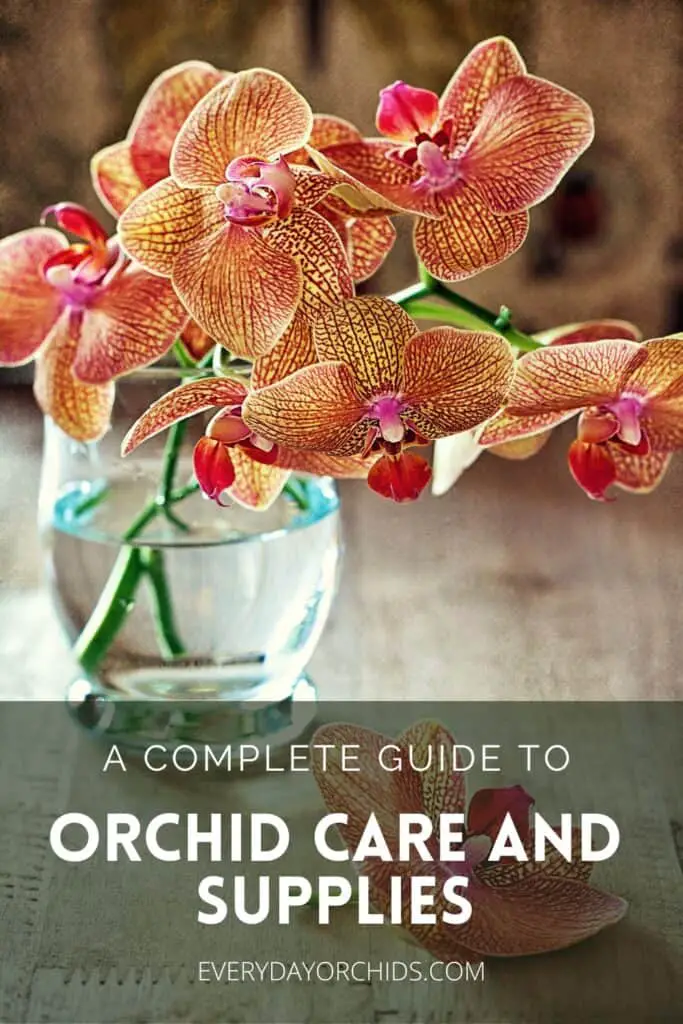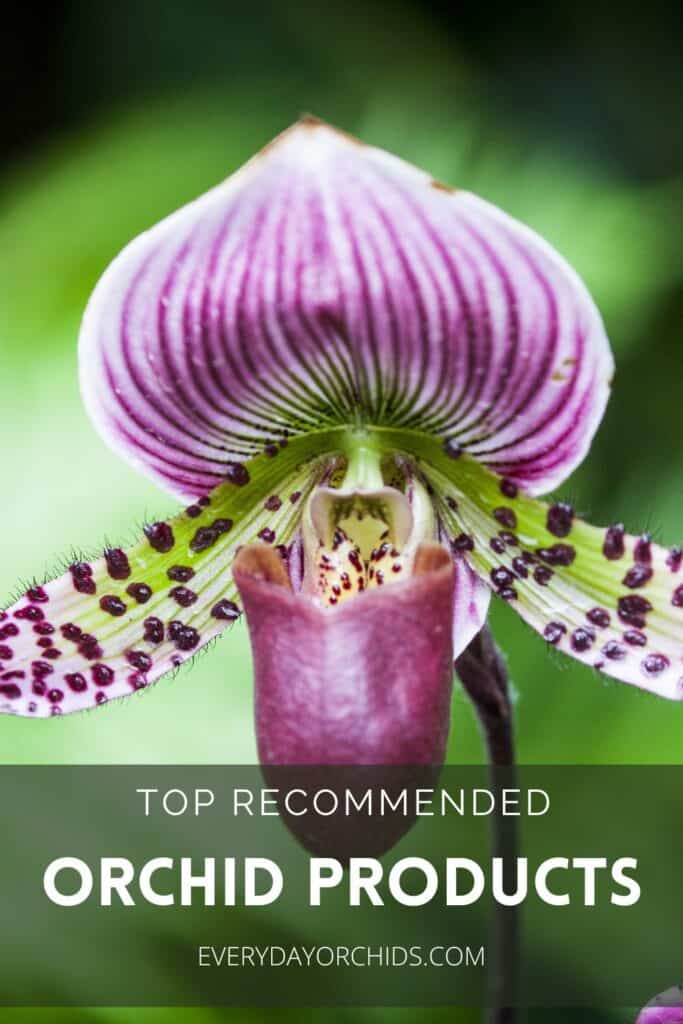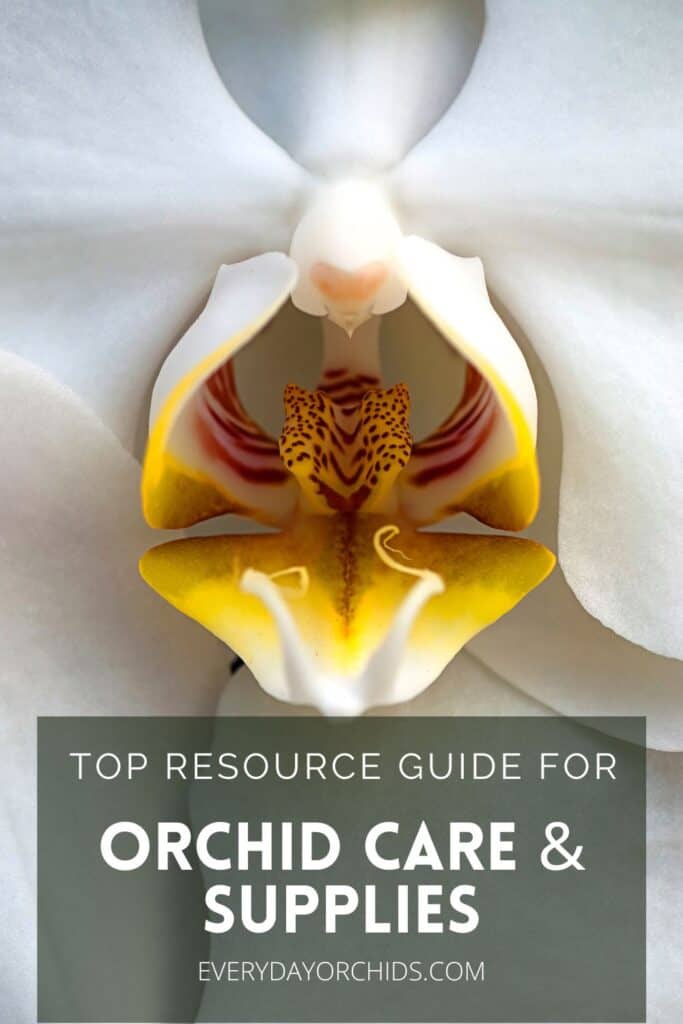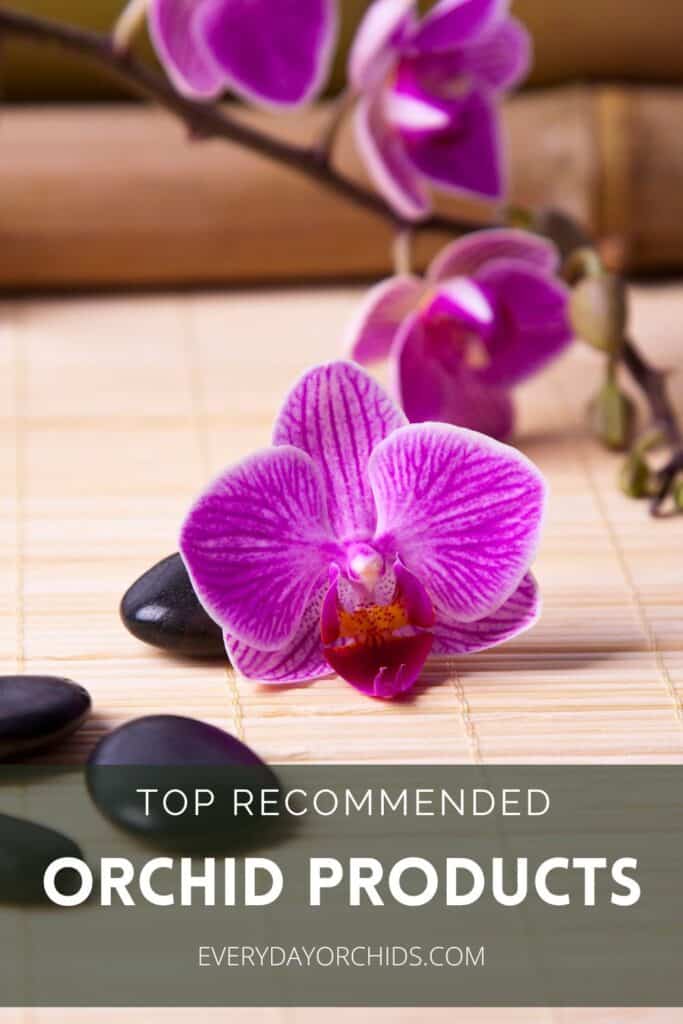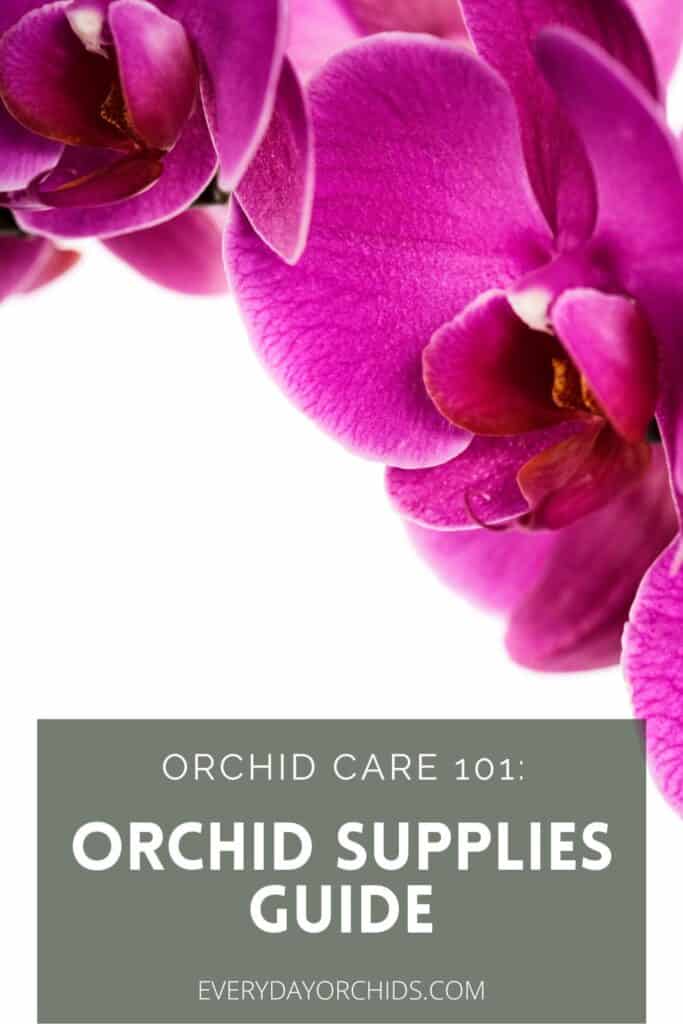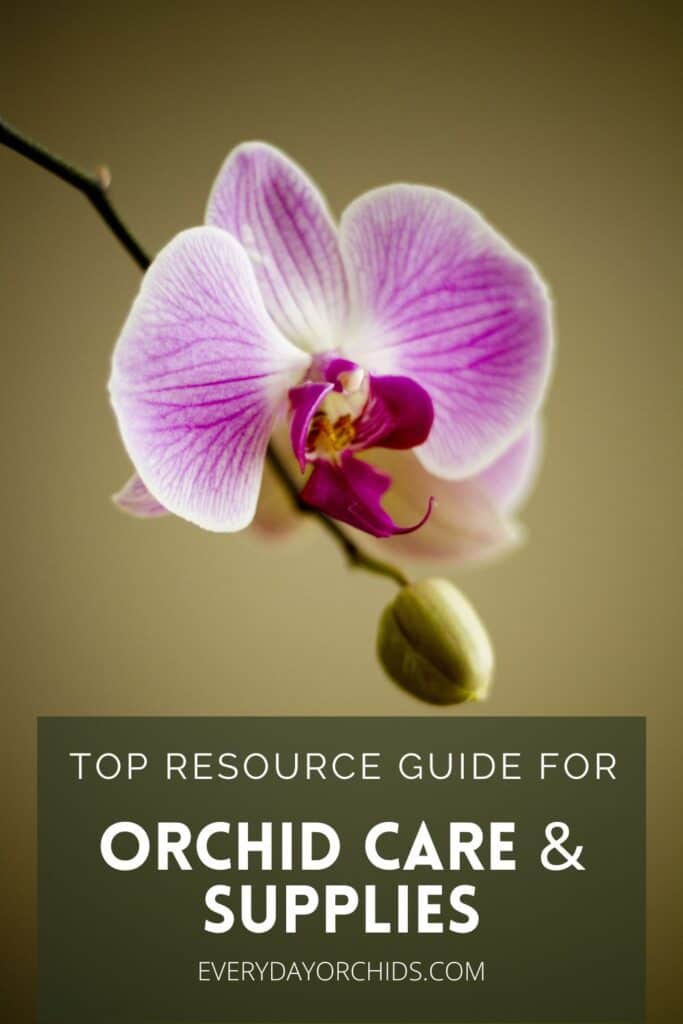Hi everyone! Welcome to my resource and product page for orchid supplies and all things related to orchid care.
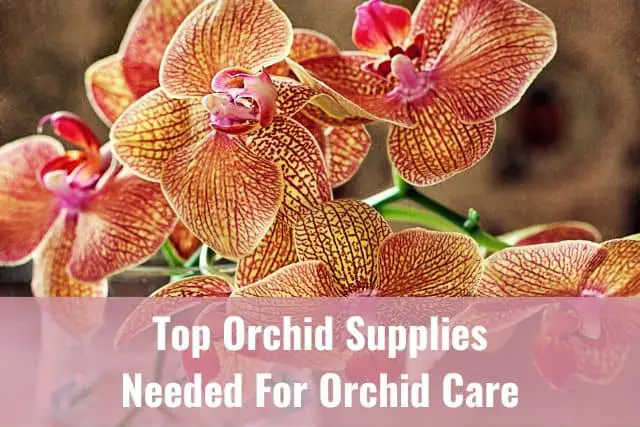
I’ve separated my orchid growing supplies by topic and have provided you with links to resources and how-to guides, as well as suggested products you can use in your orchid care.
I have recommended many of these items in my orchid care guides throughout my site. However, I also wanted to put everything, guides and recommended orchid supplies, in one place for easy reference and access. I will continue to update this page regularly with new guides and resources as I create them!
Of note, many of these orchid growing supplies are ones I have personally used and would recommend. Other orchid care products are highly reviewed and recommended by other users.
All in all, this is your one stop shop for orchid growing supplies and information related to orchids and orchid care. I hope you find this resource helpful. Please feel free to use the table of contents to jump to the section you are looking for. 🙂
Please note that these links are affiliate links and as an Amazon Associate, I earn from qualifying purchases. Purchases made through affiliate links in this post may generate commissions at no additional cost to you. Use this link to try Amazon Prime for free for 30-days. Thank you for your support!
Table of Contents
Orchid Pots And Repotting Supplies
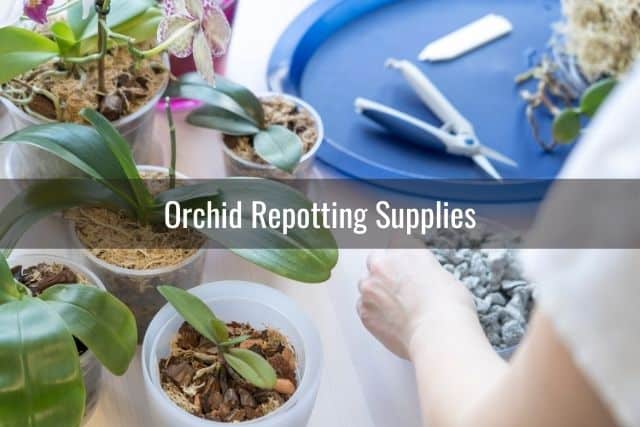
When preparing to repot your orchid, you’ll need to first gather the right supplies. This may include gardening tools, pruning shears, new orchid pots and new orchid potting media. If you are new to repotting, you may want to check out these resources before you start:
- How to repot an orchid (a step-by-step guide).
- How to repot an orchid with air roots.
- Choosing the right orchid pot.
- All about orchid potting media. This guide gives more detailed information about the different components of orchid potting media–very useful if you want to create your own custom mix.
- Orchid potting media: the difference between bark and moss. For when you are trying to decide which kind of potting media to use! This outlines the pros and cons of each.
- Alternative potting media options, including information with sphagnum moss, lava rock and so on.
- How to deal with orchid root rot, an orchid without roots, or an orchid with dried, shriveled roots.
That said, here are some suggested orchid repotting supplies:
Orchid Pots
- Clear Slotted Pots By RepotMe. This is a set of 8 pots and comes in varying sizes of 3-inch, 4-inch, 5-inch and 6-inch (2 pots per size). I personally use these pots and like them. The varying sizes in each pack are great for accommodating orchids of differing sizes.
- ELIT Plastic Orchid Pots: These clear plastic pots have small holes along the sides for aeration and drainage. Unlike the RepotMe pots, each set of ELIT pots comes in one size. I have also bought these pots in the past and find them to be good quality.
- 7-inch Pack Of Clear Slotted Orchid Pots: This is a good size for larger orchids or sympodial orchids that need room to grow laterally.
Orchid Potting Media
Most people like to use bark-based media for potting their orchids, while others prefer sphagnum moss. You can read about the difference between potting an orchid in bark vs. moss here.
Besides these two options, there are many different types of orchid potting media available out on the market. When choosing which orchid potting media to use, the decision boils down to the type of orchid you have, its care needs, and your personal preference.
Bark-Based Orchid Potting Media
- SunBulb Orchid Potting Mix: This is a great orchid potting mix for Cattleyas, Dendrobiums, Phalaenopsis, Paphiopedilums, Oncidiums, and many other epiphyte orchids. A 4-quart bag such as this one should be enough to repot three to four 4-inch orchid pots, or two 6-inch orchid pots.
- Perfect Plant All-Natural Orchid Potting Mix: This mix is hand-blended and contains pine bark, coconut chips, and charcoal. It is a great choice for Phalaenopsis orchids.
- rePotme Classic Orchid Potting Mix: This is a hand-blended, high-quality mix that can be used for most orchid types.
Sphagnum Moss
- SunBulb Orchid Sphagnum Moss: You can use sphagnum moss as a potting media for your orchids, to save an orchid without roots, or to propagate new orchids. This sphagnum moss can last you quite a long time, depending on what you use it for. A little sphagnum moss can go a long way since moss expands when wet.
- Legigo Sphagnum Moss Potting Mix: This is a smaller bag of sphagnum moss. Use this if you just have a few small orchids in your collection.
- New Zealand Sphagnum Moss: Although the packaging advertises this for use in terrariums, you can certainly use it for your orchids. I’m including this here because some orchid growers swear by New Zealand moss and feel it’s quality is superior to other mosses.
Other Potting Media
- Coarse Perlite: I actually buy a separate bag of perlite and mix it in with the orchid bark potting mix. Perlite helps with drainage and aeration. Although most orchid bark potting mixes include some perlite, I always like to add a little more.
- Charcoal: Charcoal is great for drainage and improving aeration. It also helps filter bacteria. You can read more about charcoal as an orchid potting media here.
- Coconut Husks/Fiber: I want to mention coconut fibers here because these are commonly used in orchid potting media. They are lightweight and airy. Coconut fibers can be added to your custom orchid potting mix for better drainage. However, they also have the benefit of being able to retain water. This allows coconut fibers to slowly release moisture to the orchid’s roots over time.
- LECA Clay Pebbles: LECA pebbles are most often used as a potting medium on semi-hydroponic situations. They are excellent for aeration and their porous nature allows them to absorb water. The water is then slowly released to the orchid roots as the orchid needs moisture.
Orchid Supplies Related To Light And Humidity
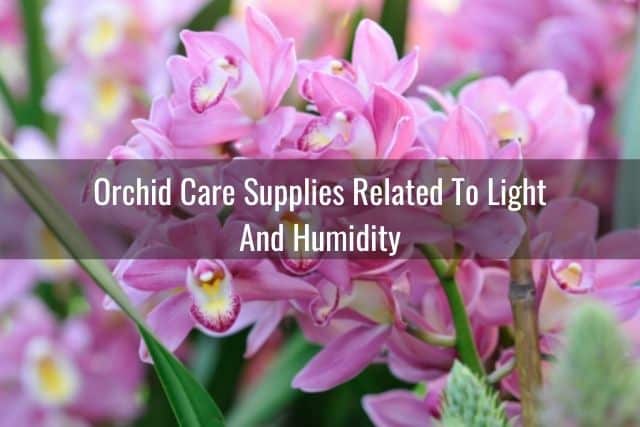
Lighting and humidity, along with proper watering and care, are key components to growing healthy orchids.
Did you know that not enough light can cause an orchid to not rebloom? Or that low humidity levels can lead to pleated orchid leaves or dried shriveled roots?
Here are some resources to help you learn more about setting up the right amount of lighting and humidity for your orchids:
- How much light do orchids need? This covers the basics and includes information on how you can figure out how much light your orchid is getting.
- Artificial lighting and orchids. Everything you need to know about setting up grow lights and artificial lighting for your orchids.
- Why is humidity so important for orchids? This guide will get you started on how to figure out humidity levels in your home and why humidity is essential to helping orchids thrive.
- Easy ways to increase humidity levels in your orchid’s growing area.
Grow Lights
- EZORKAS Grow Light: This grow light has 3 cycle timing modes 5 dimmable modes. It also has colors from the blue and red light spectrum to meet your orchid’s light needs.
Hygrometer
- ThermoPro Indoor Hygrometer: I have this exact hygrometer in my orchid’s growing area. I like it because it gives you humidity and temperature readings as well as the daily range for both. It isn’t too big or obtrusive and is a great hygrometer for the price.
Humidifier
- Aqua Oasis Cool-Mist Humidifier: I have something very similar to this humidifier and I like it for the large capacity, quiet mode and adjustable settings. Great for providing extra humidity to orchids.
- Levoit Cool-Mist Humidifer: This has a 4L capacity and can last up to 40 hours if the tank is full. It has adjustable settings and a quiet mode, which makes it perfect for bedrooms and office settings.
Spray Bottle
- Spray Bottle With Fine Mist Spray: Having a spray bottle with a fine mist spray nozzle on hand is a must. You can use it for misting your orchids or for applying neem oil or insecticide treatments.
- Driew Plant Mister Spray Bottle: This is a 10-ounce bottle with a fine mist nozzle, perfect for plants.
- Set of 7 clear plastic spray bottles: I actually have these spray bottles and find them great for my orchids and household cleaning tasks. It comes in a set of seven 8-ounce bottles. I keep one bottle of just plain water for misting, another bottle with prepared fertilizer mist spray, and yet another one dedicated to pest control purposes (neem oil solution or insecticide use).
Circulating Fan
- Honeywell Circulating Fan: This is a table-top compact circulating fan. Use this type of fan to circulate air in your orchids’ growing area, but avoid pointing it directly at your orchids.
- Portable Handheld Fan: A small-sized fan such as this one is more ideal if you have a mini greenhouse, humidity box for your orchids, or some sort of enclosed orchid growing area. Since it is battery-operated, you don’t have to worry about cords or wires.
Humidity Tray
- Humidi-Grow Humidity Tray: This tray allows water to drip down and away from orchid pots, so that the pots are not left sitting in a pool of water.
- Decorative Tray With Rocks: This is a smaller tray designed for bonsai plants, but can also be used for orchids. Has nice decorative rocks lining the tray. You can place your orchid pot on top of the rocks and just fill the tray with water halfway up the rocks for extra humidity around your orchid.
Thin Curtain
- Sheer Voile Curtains (2 panels): Use thin curtains such as these to reduce the amount of direct light your orchids are exposed to. A sheer curtain is essential if your orchids are sitting by a window that receives the bulk of the afternoon sunlight.
Orchid Pruning Supplies
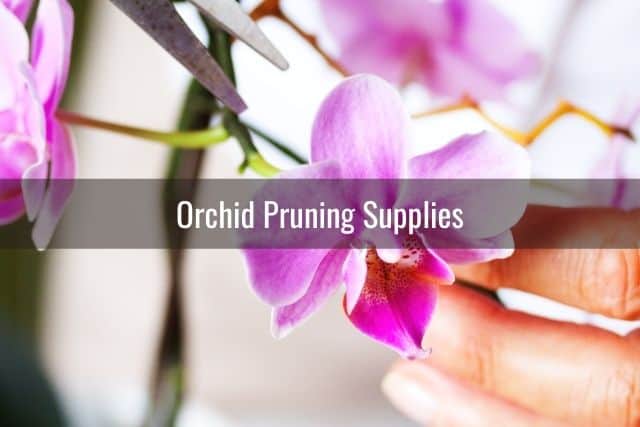
Regular pruning and maintenance of your orchids is necessary to keep them looking good. It’s also necessary to remove dead plant matter to prevent pests and disease.
If you are new to orchids and unsure what is the best way to prune your orchids, please check out these guides before you start:
- How and when to prune orchids.
- How to prune Dendrobium orchids (a little different than Phalaenopsis orchids).
- Easy ways to sterilize and disinfect your pruning tools. This is a must for preventing the spread of disease.
Here are some suggested orchid pruning supplies to get you started:
Gardening Tools
- 3-Pack Pruning Shears Set: This set has 3 different type and sized pruning shears and includes a pair of gardening gloves. It makes a good starter set for any orchid grower.
- Vivosun Pruning Shears: This is a 6.5 inch pruning shear with stainless steel blades. Great for simple pruning jobs and routine pruning of your orchids. There is also a 2-pack of pruning shears available for slightly more if a 2-pack would work better for your needs.
Gloves
Always wear gloves when repotting orchids, dealing with pest infestations or diseased plants, or when handling sphagnum moss!
Here are some recommended gardening gloves to use when providing orchid care:
- Breathable Gardening Gloves: I use these gloves when caring for my orchids. They are lightweight, flexible and not overly clunky or thick. This makes it easier to handle delicate orchid roots when repotting. They are also fairly inexpensive. The only downside is that they are not water-proof and they sometimes make my hands smell like rubber.
- Soft Jersey Gardening Gloves: I like these gloves because they are also lightweight, but made of a soft, jersey cloth material. While they are not water-proof, they are flexible and great for use when pruning or repotting orchids.
Disinfecting And Cleaning Supplies
Sterilizing your gardening tools is key after you prune or repot your orchids. It takes just a minute to do it but can go a long way in preventing the spread of disease and pathogens among plants. Here are some tools I recommend:
- Blow Torch: Small propane torch, useful for disinfecting and sterilizing blades of gardening shears during and after pruning.
- Lighter: An alternative to the blow torch, but obviously does not produce as strong of a flame.
- Rubbing Alcohol: I use rubbing alcohol most often to sterilize my gardening tools because it is fast and easy. Of course, you wouldn’t want to use this and a flame on your tools (fire hazard!). Just do one or the other.
Orchid Staking Supplies
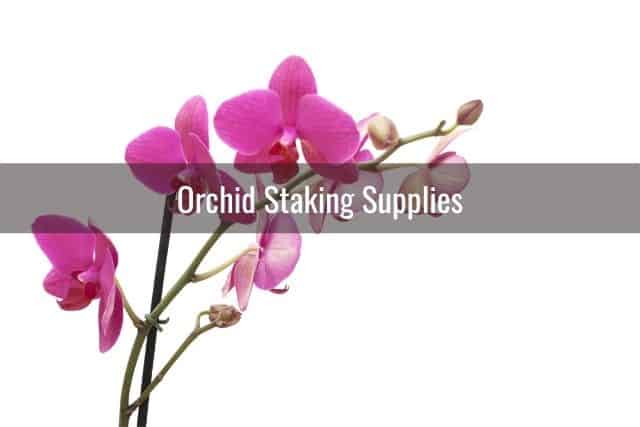
When your orchid starts developing flower spikes, pay close attention. Once those flower spikes are at least several inches long, you’ll want to start looking into staking them for support, especially if you have a top-heavy Phalaenopsis orchid. Here are two guides to get you started:
- How to stake orchid flower spikes. Learn the basics!
- How to train orchid flower spikes into unique shapes. This is more for advanced orchid growers and you will need to use Phalaenopsis orchids for this.
Orchid Stakes And Clips For Supporting Orchid Flower Spikes
You can reuse stakes and clips. Just be sure you disinfect them between orchids. Most likely, you’ll only need to buy one set of stakes and clips, and that should last you a long while.
- Stake Set With Clips: This is a good starter set that includes 20 stakes, 40 clips and 20 twist ties. You can use either clips or twist ties to secure your flower spikes to a stake. With this set, you have both options.
- Vertical Bamboo Stakes: These are ideal for Phalaenopsis orchids and those heavy cascading flower spikes.
- Orchid Clips Set: This includes 100 dark green orchid clips. You will likely end up using anywhere from 2 to 4 clips for each flower spike, so this set will be perfect if you have several orchids.
- Rubber-Coated Support Wire: I like this because it is a 12-foot long support wire that you can cut down to size using scissors or gardening shears. You can snip off sections to create twist ties for your orchid flower spikes. If you have a vanilla orchid vine, you can use this support wire to secure the vine to support poles as well.
- Half-Ring Metal Support Cage: I use this sort of support for my Oncidium and Miltoniopsis orchids. This type of support cage is most ideal for orchids with many canes or reeds that might lean over the sides of the pot. A circular support such as this one keeps the orchids looking tidy.
Dealing With Rot Or Fungal Problems In Orchids
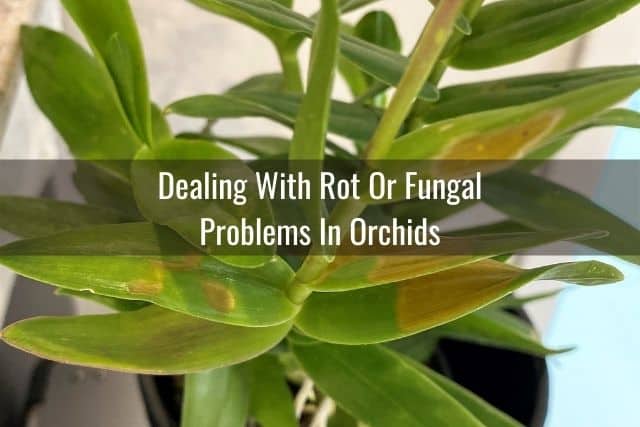
Rot and fungal infections can be fairly common in orchids and a pain to deal with.
If you are trying to figure out what you are dealing with on your orchid, check out these treatment guides below. In addition to treatment options, I also outline what you may see in your orchid to help you figure out what is going on.
- Crown rot in orchids: how to identify and treat this.
- Stem rot in orchids: what this is and how to treat it.
- Brown spot and brown rot in orchids.
- Top problems you may see in orchids, including how to identify various diseases and fungal problems and how to treat them.
- Root rot in orchids. This is very common and this is a guide on how to address root rot in your orchid.
- Dealing with mold and fungus in orchids.
Here are some suggested anti-fungal orchid care supplies. These products will help you treat fungal or rot problems in your plants.
Natural Or Low-Cost Orchid Supplies For Treating Disease
- Ground Cinnamon: I use ground cinnamon powder for sealing cut orchid ends after pruning and when dealing with stem rot and crown rot problems on my orchid. Ground cinnamon powder is inexpensive and an effective anti-fungal and desiccant. You can learn more about how ground cinnamon powder can be used on orchids here.
- Hydrogen Peroxide: Useful for dealing with stem rot and crown rot situations.
- Razor Blade For Cutting Plants: In cases like stem rot or brown spot, you may find that you need a precise cutting tool to help remove infected plant tissue on the stem or close to it. Instead of using pruning shears, use razor blades like this one to help you make those clean, close cuts.
Fungicide Products
- Physan20: This is a fungicide, virucide, and bactericide. It is safe for use on orchids. Use this to kill off any fungal, bacterial or viral pathogens that may be lingering on your orchid plant after you have already removed rotted roots or infected plant tissue. To dilute Physan 20 for use on orchids, dilute 2 teaspoons of Physan per gallon of water per their website instructions.
- Southern Ag Powered Antifungal: This can be mixed in water (follow product instructions) and used to treat root rot, black spot, leaf spot, brown rot, and a host of other fungal diseases that affect orchids.
- Bonide Copper Fungicide: Copper fungicide is useful for dealing with black spot and other fungal problems.
Orchid Supplies For Pest Control
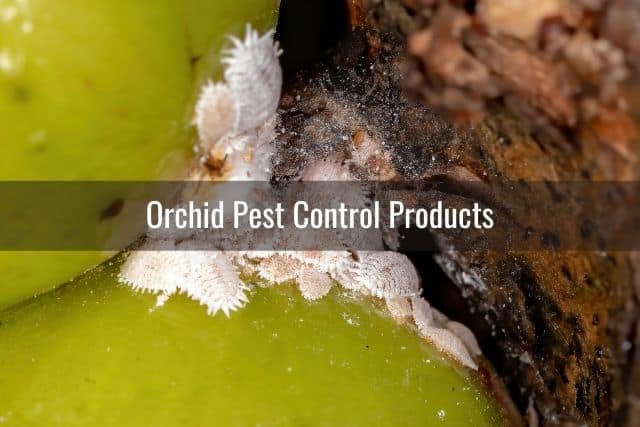
Orchid pests are notoriously difficult to deal with, especially if you are dealing with a severe infestation. I’ve written a number of guides to help you deal with various pests, as listed below. As I write more orchid pest guides, I’ll add them here.
- Top problems in orchids. This is a general guide that covers a variety of orchid care issues, including various pests and diseases.
- How to get rid of orchid pests. This is another all-in-one guide covering a wide variety of orchid pests, along with treatment methods.
- Fungus gnats. This is a very detailed guide to fungus gnats, including how to identify them, their life cycle, and various ways you can get rid of them.
- Mealybugs. Mealybugs on orchids are the bane of many orchid growers. Here is a detailed guide to addressing a mealybug infestation.
- Orchid scale. Everything you need to know about orchid scale and how to deal with a scale infestation on your plant.
- Spider mites. A detailed guide to spider mites and how to get rid of them from your orchid.
- Thrips. Thrips are notoriously hard to spot and often times, you realize you have a thrip infestation based on the thrip damage on your orchid. Here is a detailed guide on how to deal with a thrip infestation.
Here are my favorite orchid pest control supplies to keep on hand:
- Rubbing Alcohol (Isopropyl alcohol): I use rubbing alcohol to deal with minor pest infestations, particularly with regards to mealybugs. I find that this is an easy and inexpensive way to get rid of orchid pests, but only if you have a handful of pests. Once you have a full-fledged infestation going on, you’ll need to step-up to the next level of treatment below.
Horticultural Oils And Insecticidal Soap
- Bonide Ready-to-use Neem Oil: Neem oil is a type of horticultural oil. It’s great for dealing with aphids, spider mites and scale. It is organic, non-toxic and safe to be used around pets and children. I wrote a whole post on using neem oil on orchids, so check that out for more information, including how to prepare and apply neem oil to orchids.
- Bonide Insecticidal Soap: Use this to kill a variety of pests, including aphids, spider mites and thrips on your orchids. Spray directly on the pests and watch them die within minutes. It can be used on a variety of plants, but always do a spot test on a small area of your orchids first.
Insecticides and Pesticides
- Bonide Systemic Insect Control For Plants: This is a granular pesticide that is effective against thrips, fungus gnats and other pests. Most people sprinkle a thin layer of this over the top of their potting media before watering, but I recommend following the product instructions before use. Test it on one area first before using on all your orchids.
- ArgoMagen GrowSafe Pesticide, Fungicide and Insecticide: This is a 3-in-1 solution for killing soft-bodied orchid pests such as aphids and spider mites. It is all-natural so safe around humans and pets and is safe for use on orchids. This is also great for hydroponics! This product can be used if you find white mold on your orchids and the surrounding potting media.
- BotanoHealth Pesticide and Fungicide: This can be used for both pest control as well as treating fungal diseases in orchids. It can be used to kill spider mites and aphids. You can also use this to treat Botrytis, Fusarium and black spot, just to name a few.
Orchid Fertilizer And Supplements
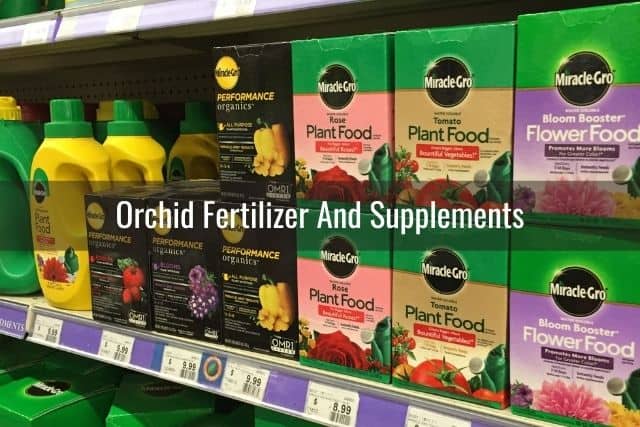
When buying fertilizer for your orchids, you want to make sure you get an orchid-specific fertilizer. For basic fertilization needs, a balanced 20-20-20 orchid fertilizer will be sufficient. To increase flower production, a bloom booster fertilizer will be best. If you aren’t sure how to fertilize your orchids, here are some resources to get you started:
- How to fertilize your orchids. This covers all the basics!
- How to make homemade orchid fertilizer. This is perfect if you want to try to save some money and use kitchen scraps for making orchid fertilizer. This is a step-by-step guide with recipes.
- Using a fertilizer mist spray. This is another option for fertilizing orchids.
- Rooting hormone and orchids. Rooting hormone can be used to provide extra support for orchids that are recovering from shock and trauma or are being propagated.
- Epsom salt on orchids. You can use an Epsom salt soak solution to treat dehydrated roots. But did you know you can also use it as a nutritional supplement for orchids?
- Can I use Miracle-Gro fertilizer on my orchids? Everything you need to know about using Miracle-Gro on orchids, the pros and cons, and how to pick the right Miracle-Gro product.
- Five reasons why you should use seaweed fertilizer on your plants. Learn how you can super-charge root growth and plant health with seaweed and kelp fertilizers.
- How to use seaweed fertilizer on your orchids. Find out how to dilute and prepare seaweed and kelp fertilizers for your orchids.
There are lots of options for orchid fertilizer, including urea-free fertilizer, slow-release granules, and powder concentrate. Here are a few products that I have either personally used and/or are highly reviewed and recommended online.
Balanced Orchid Fertilizer
- Miracle-Gro Water Soluble Orchid Fertilizer: This is a balanced 20-20-20 orchid fertilizer that will need to be dissolved in water before use. Follow the product instructions carefully, as a little goes a long way. I have used this product in the past and it lasts a long time.
- rePotme Orchid Food: This orchid fertilizer is urea-free and is recommended for use with reverse osmosis water, rain water or low alkaline water. To prepare this for your orchids, mix 3/4 teaspoon of fertilizer into one gallon of water.
Bloom Booster Fertilizer
- SunBulb Bloom Booster Fertilizer: The high phosphorus content of this fertilizer helps your orchid create more plentiful, colorful blooms. As an added bonus, it does not contain urea nitrogen.
- JR Peters Liquid Bloom Booster: This bloom booster fertilizer can be used on all orchid varieties. Just mix 1/2 capful of liquid fertilizer in 1 gallon of water to feed your orchids in the months leading up to the blooming season.
- The GrowCo’s Bloom Booster Fertilizer Mist Spray: If you prefer to feed your orchids using a fertilizer mist spray (AKA foliar feeding), this one is perfect for you. Use this spray on the underside of your orchid leaves each week. You can read more about how to feed your orchids with a fertilizer mist spray here.
Seaweed And Kelp Fertilizers
- CleanKelp: This is an organic kelp fertilizer made by Bloom City. It is sold concentrated so you will need to dilute it before use.
- Liquid Seaweed: This is another popular seaweed fertilizer used by orchid growers. Like all seaweed and kelp fertilizers, this is not meant to be used as the sole source of nutrition for orchids. Instead, use a balanced 20-20-20 fertilizer on your orchids along with a seaweed fertilizer.
- Orchid Love: Unlike the other two options, which can be used on all plants, Orchid Love is a seaweed fertilizer specific to orchids. It will help with root growth and development, keep your orchid leaves nice and green, and help maintain the orchid’s overall health.
Orchid Propagation Supplies

Orchid propagation is an easy way to grow your orchid collection without having to buy more orchids. If you are interested in doing this, read my guide on how to propagate orchids to get step-by-step instructions on how to do this.
In the meantime, here are the basic supplies you’ll need to propagate orchids:
- Keiki Cloning Paste: I like this particular cloning paste by Southside. Not only is it specific for use on orchids, but it includes applicator swabs and a step-by-step picture guide for applying the cloning paste. This is perfect, especially if it is your first time propagating orchids.
- Sphagnum Moss: Sphagnum moss is required to provide humidity and moisture to your growing orchid keiki’s roots.
- Rooting Hormone: As you may have guessed, rooting hormone helps orchids develop and grow more roots. You can read more about how to use rooting hormone on orchids here.
- Humidity Dome Tray: This is a simple plastic tray pack with a clear dome-shaped lid, perfect for propagating orchid keikis. This pack includes 3 trays with 3 lids.
Orchid Home Decor And Other Orchid Growing Supplies
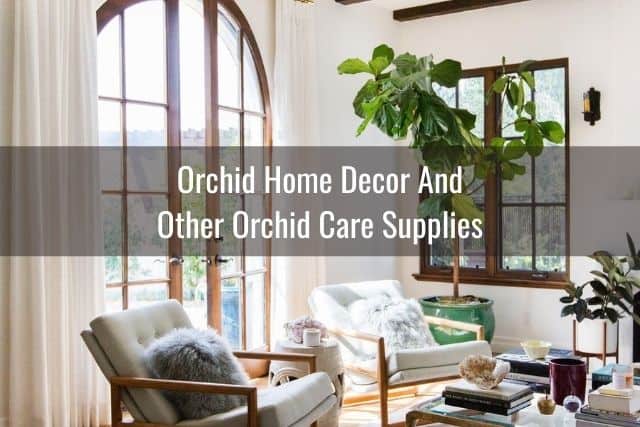
Plant Stand
- Amazon Basics Plant Stand: Keep your orchids elevated and off the ground with this sleek plant stand.
Vases
- Tall-Neck Glass Vase: Perfect for cut orchid stems, this vase has a slender tall neck to support the delicate orchid blooms and prevent them from bending over time.
